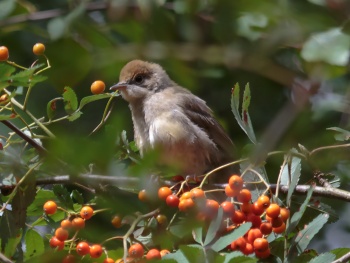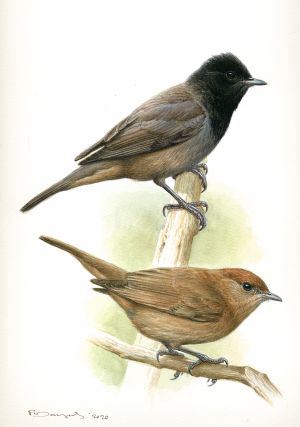Sbarnhardt (talk | contribs) (Amend GSearch with new combined search,) |
(→External Links: New Video search created) |
||
| Line 54: | Line 54: | ||
==External Links== | ==External Links== | ||
{{GSearch| "Sylvia atricapilla" {{!}} "Eurasian Blackcap"}} | {{GSearch| "Sylvia atricapilla" {{!}} "Eurasian Blackcap"}} | ||
| − | + | <br /> | |
| − | {{ | + | {{VSearch| "Sylvia atricapilla" {{!}} "Eurasian Blackcap"}} |
| − | {{GS-checked}} | + | {{GS-checked}}1 |
<br /> | <br /> | ||
<br /> | <br /> | ||
[[Category:Birds]] [[Category:Sylvia]] [[Category:Bird Songs]] [[Category:Videos]] | [[Category:Birds]] [[Category:Sylvia]] [[Category:Bird Songs]] [[Category:Videos]] | ||
Latest revision as of 18:05, 9 February 2023
- Sylvia atricapilla
Identification
13.5-15cm (5¼-6 in)
- Greyish-brown upperparts
- Light olive-grey underparts
- Crown is glossy-black in male - reddish-brown in female and juvenile.
Variation
On several of the Atlantic islands that have resident Blackcap, there is a partly melanistic morph (Veiled Blackcap) which may occur in about 2% of the birds in Madeira and the Azores, less on the other islands (see image further down this page).
Distribution
Widespread and generally abundant in the Western Palearctic.
Breeds in the British Isles (except western Ireland and northern Scotland), and from Iberia and France east to the Urals.
Range extends to 70 degrees north in coastal Norway, to the head of the Gulf of Bothnia in Sweden, southern Finland and almost to the White Sea in Russia. In the south found as far as southern Spain, the Balearics, Corsica, Sardinia and Sicily, Italy, Greece and northern Turkey east to the Caucasus. Also breeds on the Azores, Madeira, Canary Islands, Cape Verde Islands and in northern parts of Morocco and Algeria.
Birds from central Europe eastwards and north to Scandinavia are migratory, wintering in sub-Saharan Africa and in western Europe from Britain southwards, around the Mediterranean and in North Africa. Western and southern birds are resident or partially migratory, incidence of wintering is increasing in Britain and North-West Europe. Most British birds migratory, arriving in April-May and departing August-September with variable but generally small numbers wintering.
Vagrants have been recorded in Iceland while it is seen quite commonly during migration in the nearby Faroe Islands.
Taxonomy
Subspecues
There are 5 subspecies[1]:
- Nominate race occurs over much of Europe.
- dammholzi in the Caucasus, greyer above, whiter below and paler crown in female.
- In the Mediterranean pauluccii is found on the Balearics, Corsica, Sardinia, Sicily, Italy and Tunisia, also greyer above but darker below.
- Race heineken is found in western Iberia, north-western Africa and on Madeira and Canary Islands, darker and smaller than nominate, especially on Madeira.
- Race gularis from Azores and Cape Verde Islands is very similar to nominate differing only in minor measurements.
Habitat
Deciduous, mixed and in some areas, coniferous, forest and woodland with tall shrubs, sometimes in scrub with taller trees nearby. Also in parks, large gardens and orchards. In winter occurs in a wide range of habitats with trees and bushes and a frequent visitor to garden birdtables in parts of Europe.
Behaviour
Diet
The diet includes insects and berries.
Breeding
The female builds a cup shaped nest from vegetation and mud, placed in a hedge, bush, or brambles. 4-6 glossy, smooth, pale buff with dark markings eggs are laid. They are incubated by both parents who both feed the young.
Vocalisation
Call: teck or tacc (louder than Lesser Whitethroat)
Song: Sings from a concealed perch. Beginning is similar to Garden Warbler but less sustained; ends with flutey notes.
Recording by Waxwings
Liguria, northern Italy, July 2016
References
- Clements, J. F., T. S. Schulenberg, M. J. Iliff, S. M. Billerman, T. A. Fredericks, B. L. Sullivan, and C. L. Wood. 2019. The eBird/Clements Checklist of Birds of the World: v2019. Downloaded from http://www.birds.cornell.edu/clementschecklist/download/
- Collins Pocket Guide to British Birds 1966
- Collins Field Guide 5th Edition
- Collins Bird Guide ISBN 0 00 219728 6
- British Garden Birds
- Paper from "The Bulletin of the African Bird Club" about the Veiled Blackcap
Recommended Citation
- BirdForum Opus contributors. (2024) Eurasian Blackcap. In: BirdForum, the forum for wild birds and birding. Retrieved 27 April 2024 from https://www.birdforum.net/opus/Eurasian_Blackcap
External Links
GSearch checked for 2020 platform.1








